During the Hellenistic Period Greek Art Was Characterized by Look at This Image This Is
Hellenistic sculpture is 1 of art history's virtually prized practices. Historic for its unprecedented naturalism, this movement introduced a practiced sculptural approach that artists would emulate for years to come.
Today, Hellenistic antiquities can be institute in top collections across the earth, with world-famous works similar the Winged Victory of Samothrace leading the way. While yous may be familiar with these awe-inspiring marble sculptures, you lot may not know much nearly the very movement that they shaped.
What was the Hellenistic Period?
TheHellenistic period was an era in Ancient Greece that lasted from 323 BCE to 31 CE. During this menses, sculptors pursued and perfectednaturalism—an artistic interest that Greek artists had been developing over hundreds of years.
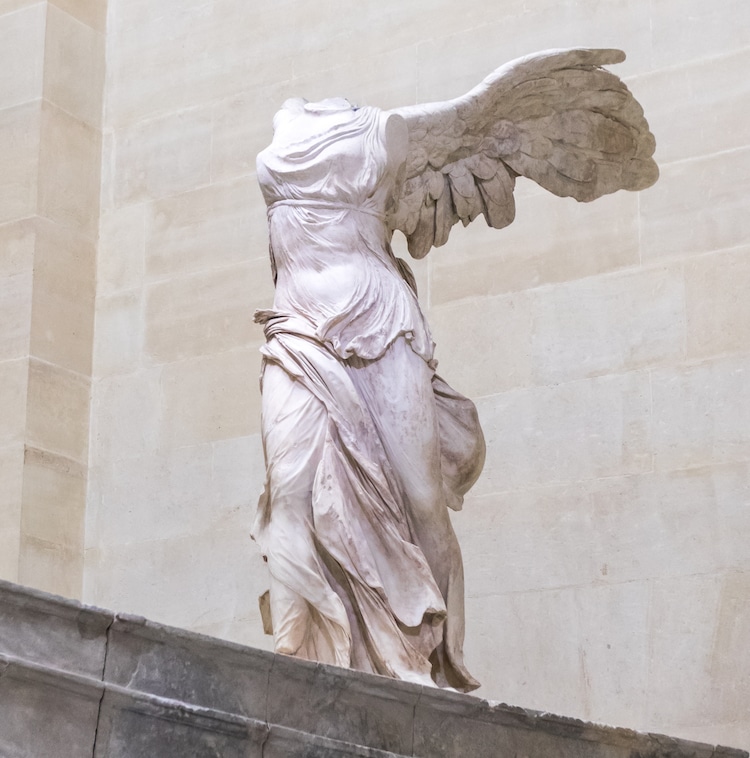
"The Winged Victory of Samothrace," 190 BCE (Stock Photos from jackbolla/Shutterstock)
A fascination with naturalistic sculpture can be traced back to Aboriginal Hellenic republic's Archaic period, which lasted from the 8th century until 500 BCE. Though sculptures crafted during this fourth dimension conveyed more realism than those that preceded them, their poses are strong and their expressions are stoic. Similarly, Archaic sculptors typically stuck to two types of figures: "the male person kouros, or continuing nude youth, and the female person kore, or standing draped maiden" (the Metropolitan Museum of Fine art).
This changed in 500 BCE, however, when the Classical period emerged. With an increased attention to detail and idealized perception of man anatomy, Classical sculptors strived for perfection in their piece of work. Consequently, they shifted their focus fromkouros and kore figures to a various and divine bandage of characters from mythology.
This approach was taken a step further in 323 BCE. At this time, sculptors adapted Classical techniques to render realistic figures. This tendency lasted for nearly 200 years and culminated in what is now known as the Hellenistic period.
Classic Characteristics
In social club to achieve this lifelike aesthetic, Hellenistic sculptors skillfully incorporated iii characteristics into their work: expressive motility, realistic anatomy, and ornate details.
Expressive Movement
In order to brand their sculptures await as human as possible, sculptors employed dynamic silhouettes and sinuous forms to suggest motility. This emphasis on expressive and exaggerated motion is especially apparent inLaocoön and His Sons, i of the period's most famous masterpieces.
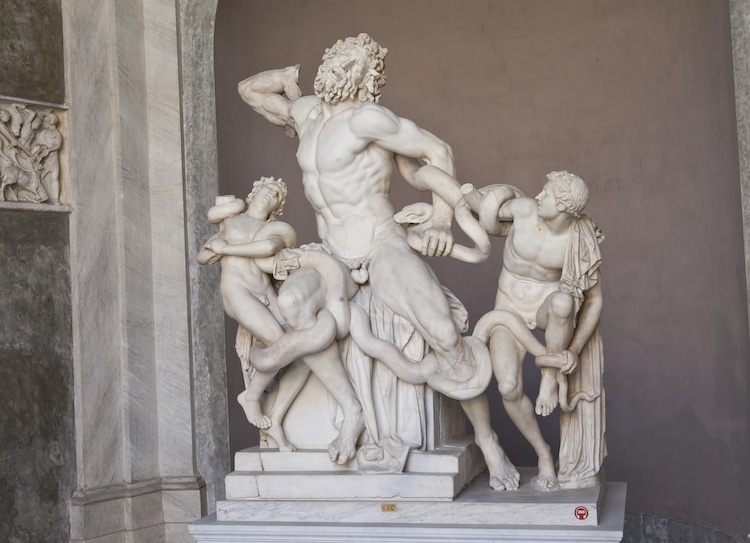
"Laocoon and His Sons," first century BCE (Stock Photos from Enrique Moya/Shutterstock)
Inspired by a Greek epic, the statue depicts 3 figures—Laocoön, a priest from Troy, and his two sons, Antiphantes and Thymbraeu—as they badly try to escape from a pair of coiled serpents. Every bit they dramatically twist and plow, they appear to entangle themselves fifty-fifty more than, culminating in the swirling, activeness-packed scene that perfectly illustrates the Hellenistic involvement in movement.
Realistic Anatomy
This preoccupation with move also informed the Hellenistic focus on anatomy. Breaking from "the universal, emotionless, and often rigid poses of the Archaic" (Google Arts & Culture) and building on Classical models, Hellenistic artists crafted sculptures inspired by real man postures. Rather than posed in unrealistically erect positions, figures like theVenus de Milo were rendered in an asymmetrical stance. Known as contrapposto ("counterpose"), this pose implies movement through the employ of realistic weight distribution and an S-shaped body.
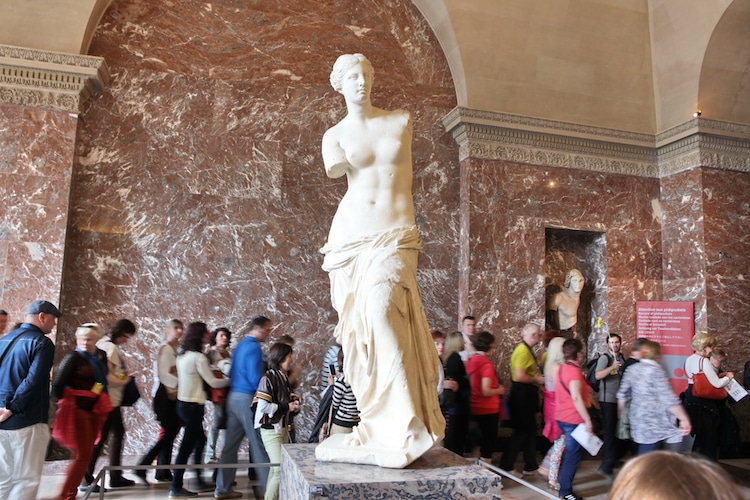
Alexandros of Antioch, "Venus de Milo," 101 BCE (Stock Photos from Tutti Frutti/Shutterstock)
In addition to natural poses, Hellenistic artists sought to replicate the bodies of real humans. While this is axiomatic in the unidealized sculptures of gods that were prevalent during the menstruation, it also manifested as statues of ordinary people. "1 of the firsthand results of the new international Hellenistic milieu was the widened range of subject affair that had picayune precedent in earlier Greek art," the Metropolitan Museum of Art explains, "At that place are representations of unorthodox subjects, such as grotesques, and of more conventional inhabitants, such as children and elderly people."
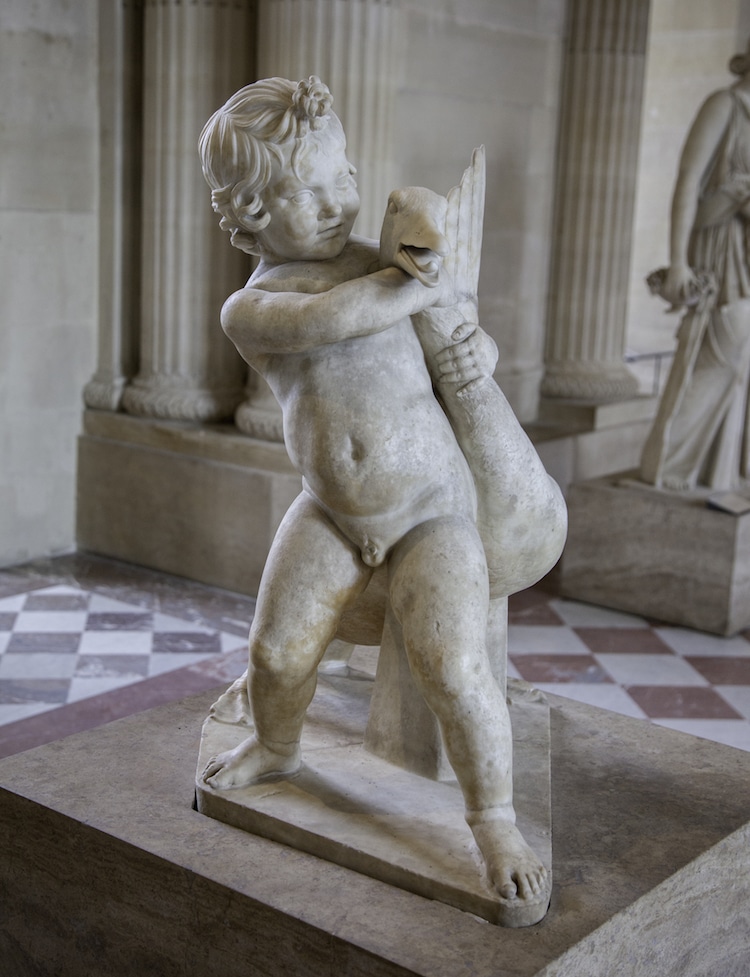
Boethos of Chalcedon, "Boy with Goose," second century BCE ((Stock Photos from time4studio/Shutterstock)
Ornate Details
A final characteristic of Hellenistic sculpture is a striking attention to item. In addition to realistic anatomical features, this is evident in pall—a sculptural element that proved specially popular during this time.
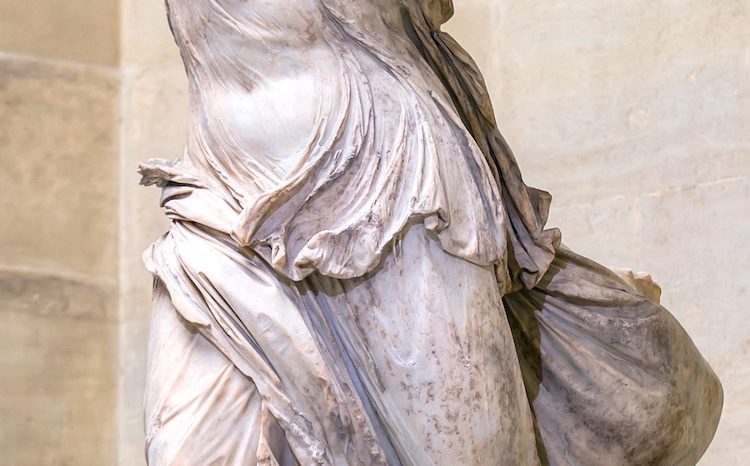
Detail of "The Winged Victory of Samothrace," 190 BCE (Stock Photos from muratart /Shutterstock)
Sculptors opted to adorn their figures with "textile" for 3 main reasons: to accentuate the suggested motion of the figure, emphasize the contours of its lifelike anatomy, and to showcase their sculpting skills. Known equally "wet drapery," this technique first appeared during the Classical menstruation and was adopted and adapted past Hellenistic artists.
Legacy
Over the course of several centuries, Hellenistic sculpture has remained one of the practice's virtually influential genres. Throughout the Renaissance, its emphasis on anatomy was emulated by Italian artists like Michelangelo; during the Baroque move, Bernini found inspiration in its dynamic movement; and, in the 19th century, Giovanni Strazza employed the "wet mantle" technique to craft the amazing Veiled Virgin.
Spanning movements, genres, and fifty-fifty centuries, these pieces—amongst many more—accept proven the lasting legacy of Hellenistic sculpture.
Related Manufactures:
How a Single Sculpture Inspired Some of Rodin's Most Famous Works
Exploring the Heavenly History of Angels in Art
The History of Cupid in Fine art: How the God of Dearest Has Inspired Artists for Centuries
headlamtharnilich.blogspot.com
Source: https://mymodernmet.com/what-is-hellenistic-sculpture-history/
0 Response to "During the Hellenistic Period Greek Art Was Characterized by Look at This Image This Is"
Post a Comment